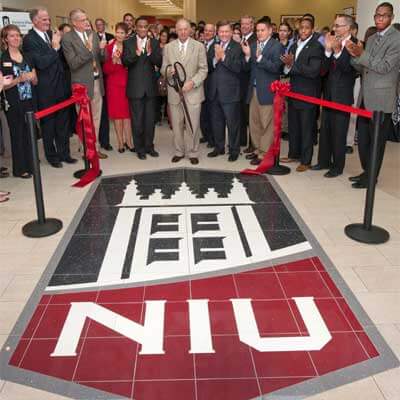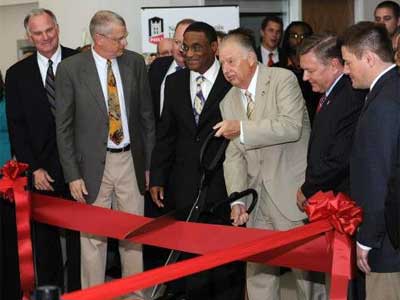For the first time in nearly a half-century, NIU students, university leaders and their partners in the construction industry gathered to cut the ribbon on a new residence hall.
NIU President John Peters led the afternoon ceremony to dedicate the new buildings, which will welcome 1,000 students next week.
“This is truly a momentous occasion. It is an event to be celebrated, and the reasons go far beyond bricks and mortar – even bricks and mortar as fantastic as this,” Peters told the crowd.
“You see, this building is the embodiment of our Vision 2020 goal of becoming the most student-centered regional public research university in the Midwest,” he said. “It is a crown jewel of our Residential Renaissance, a four-year effort to dramatically upgrade our housing to meet the modern-day needs of students.”
Peters praised the building’s “beautiful, innovative spaces,” which offer wireless technology throughout, an “amazing” food court and a “workout room that rivals any health club.”
The residential buildings will be identical structures featuring “cluster-style” living arrangements that house 12 students together.
Privacy is enhanced via 12 single bedrooms, six shared bathrooms with micro-refrigerators and a common space that includes a furnished study area, living area and kitchenette as well as a washer and dryer all within the cluster.
The community center will feature an “all-you-care-to-eat” style of dining facility, offering a variety of food options, social lounge with a gaming area where students can socialize with fellow residents or community visitors, a fitness center equipped with modern workout equipment and meeting spaces.
Outdoor amenities include a sand volleyball court, basketball half-court and bean bag courts grouped together with picnic tables. Students also will enjoy patios, benches, green spaces and 190 spaces for bicycle parking adjacent to each of the residential buildings.
Speakers at Monday’s event included Eddie Williams, executive vice president and chief financial officer for NIU; Student Association President Delonte LeFlore, and James Wilhelm, executive vice president of public/private transactions for American Campus Communities.
Timothy Brandner, president of the Residence Hall Association, said the new building “will serve as a model for a new approach to living and learning, both across the state and here at Northern Illinois University.”
“In the short amount of time that I have been a Huskie,” Brander said, “I have already seen the university’s attentiveness toward creating better opportunities for every student that steps foot on these grounds.
“This residence hall is just one example of how Northern Illinois strives as a community to be a premier source of higher education for the young minds of today,” he added, “and how Northern Illinois strives as a community to be a premier source of skilled and professional labor to the American workforce of tomorrow.”
 President Peters also praised the partnerships that helped to build the new hall, the construction of which came at no cost to the university.
President Peters also praised the partnerships that helped to build the new hall, the construction of which came at no cost to the university.
In thanking American Campus Communities, the Collegiate Housing Foundation, Pepper Construction Group and HKM Architects & Planners for their work, he recognized the challenge of the difficult financial situations faced by the university, the state and the nation.
“We appreciate how tirelessly all of you worked to make this day possible. You have given us a facility that will be a source of Huskie Pride for years, and you have set the standard for all that follow, not just at NIU, but also at universities across the country,” Peters said.
“We undertook (this) challenge,” he added, “because we recognized that we could hardly claim to be putting students first while expecting them to move into buildings that had scarcely changed since their parents – or in some cases, grandparents – had enrolled here.”

